by Carole Dazzi and Romina Ciulli
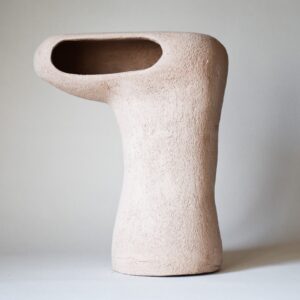
Daniela Daz Moretti, sculptor, painter, is a multifaceted artist whose works shape a personal existential journey, making her deepest and most intimate side manifest. Above all, it is through the modeling of ceramics, her medium of choice, that Daz accompanies us along this growth path, crossing themes such as childhood and adulthood, the existential meaning of memory, the allegorical border between inner world and external reality.
Her sculptures, in their alternation of empty and full, suggest a dimension of absence and emptiness, recalling the concept of nostalgia for the first memories of the past, and become fragments not only of family stories, but also of a collective time that the artist brings to light. Let’s talk about it with the artist.
The central theme of your work is nostalgia, an intimate and deep feeling, inextricably linked to the memory. We find it in your project entitled Nostalghia/Nido. Can you tell us something about this work? And how much does this feeling influence your work in general?
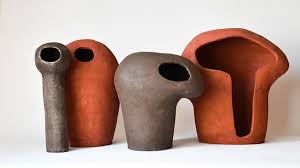
Nostalgia is a complex and profound feeling that I have tried to explore through my sculptures. Over the years, nostalgia has become a void, a sense of lack, an unfulfilled desire to reunite with a completeness that seems lost in time. My personal journey, characterized by numerous moves from one place to another, has made me feel like an exile, always searching for the roots I left behind. The Nest, therefore, becomes the symbol of a frantic search for calm, for refuge. My sculptures, which are an integrating part of the Nostalghia/Nido project, represent this duality very well. The forms, with large and empty openings, evoke the idea of the nest as a refuge, but also the feeling of lack and absence. On the contrary, the forms with smaller or even non-existent holes seem like primordial nests, essential, shapeless and incomplete. These contrasting forms recall home and the place where you belong, but they also suggest abandonment and departure. In my sculptures, as in my two-dimensional works, the two sides of the same symbolism recall and repel each other, reflecting the complex relationship between nostalgia and the sense of belonging.
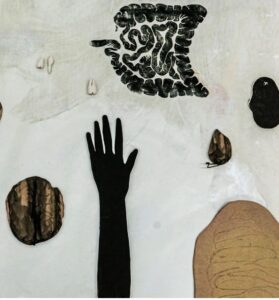
In your works we find echoes and Proustian correspondences. In particular the concept of time, considered by Proust as something living, that moves and vibrates constantly under our skin, that we believe to be dormant but instead, when we least expect it, forcefully comes out like an unexpected bleeding, investing us and bringing back to light what we thought was lost. What is time for you? How do we find it in your works?
For me, time is a complex and stratified force, far from the linear concept we often attribute to it. In my sculptural works time manifests itself as a continuous accumulation of events that return, that emerge from the past and require explanations. This cyclical and unpredictable movement strongly recalls Proust’s “madeleine”, a perfect symbol of how a simple element can rekindle memories and sensations that we thought were lost. Time, therefore, is not a linear flow, but an intricate network of connections and references, in which the links between past, present and future become confused and overlap. In my sculptures I try to capture this complexity, representing time as a living and pulsating entity. Each work becomes a meeting point between different moments in time, a place where the past re-emerges with force and questions us, asking us to confront it. This sudden and powerful return of time manifests itself in the shapes and materials I use, chosen for their ability to evoke memories and suggestions. In this sense, time in my works is no longer a linear sequence of causes and effects, but a fluid and interconnected dimension, where each moment can resonate and interact with the others, creating a continuous dialogue between past and present.
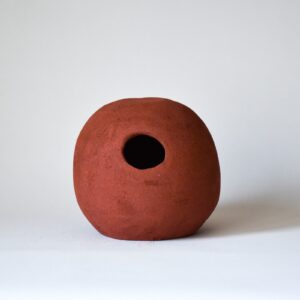
Your art is characterized by a multifaceted essence, which is reflected in the use of different materials and tools. However, you have chosen terracotta as the material of choice to create your sculptures. A medium that can be traced back to the earth, to the roots of a collective past, to the very concept of belonging. Can you tell us why you chose this material?
Terracotta is a material that allows me to connect with the roots of our humanity. Its ancient history, its malleability and its strength fascinate and inspire me deeply. Terracotta has been used for millennia by different civilizations to create everyday objects, works of art and architecture. This medium allows me to express a continuity with the past, to tell stories that resonate with a sense of collective belonging. Therefore, working with terracotta allows me to explore forms and textures in a very direct and intuitive way. Its plasticity gives me the freedom to create organic and natural forms, which often evoke anthropomorphic figures or elements of nature. Furthermore, the firing process transforms the raw material into a lasting object, symbolizing a metamorphosis which reflects growth and evolution. In my works terracotta thus becomes a vehicle to express concepts of identity, belonging and memory. Each piece is a dialogue between the past and the present, between the earth and the human being, trying to capture the essence of our connection with what is archetypal and with our common history.
Clay is a material on which you can leave a mark, that you can manipulate in an intense and physical way, a medium with its own memory and capable of collecting emotions and becoming their container. Therefore, it seems to have the ability to restart what has somehow remained blocked, as in the case of memories. Does its use have a therapeutic value for you? Does that help to restart something that you felt interrupted maybe, suspended?
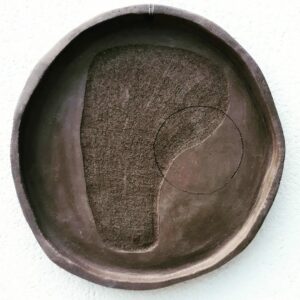
Absolutely, clay has a profoundly therapeutic value for me. The process of working with clay is intrinsically linked to a physical and tactile interaction, which allows emotions, thoughts and memories to be transferred onto the surface of the material. Every touch, every mark left on the clay, is a trace of a lived experience, a dialogue between the artist and the material. Teaching ceramics to people with physical disabilities and behavioral differences, I have seen personally how powerful this process is. Clay offers a tangible and immediate way to express what is sometimes difficult to verbalize. It can become a medium through which anyone, regardless of their abilities or limitations, can communicate and find a sense of fulfillment. For me, the therapeutic value of clay also lies in its ability to reconnect with ourselves and others. The process of manipulating clay requires attention and presence, promoting a meditative experience that helps clearing the mind and let emotions flow. This can be especially beneficial for those who have experienced trauma or have difficulty expressing themselves in conventional ways. Additionally, seeing my students find joy and satisfaction in creating with their hands is incredibly rewarding. Clay thus becomes not only a medium of artistic expression, but also a tool for healing and personal growth. This process of transformation, both of clay and of the people who work with it, is what makes my work so meaningful.
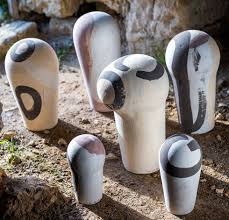
Another main theme in your works is the symbolism of the nest, universally seen as an image of protection, of family warmth. However, your nests, being visually empty, suggest in a certain way a dimension of lack and abandonment, recalling the concept of nostalgia once again. What value does the concept of nest assume in your artistic vision?
In my works the concept of nest represents a central and complex theme, which goes beyond the simple image of protection and family warmth. My nests, while evoking a feeling of refuge, are deliberately empty, creating a tension between presence and absence, between safety and vulnerability. This choice reflects a dimension of lack and abandonment, which in turn recalls the concept of nostalgia. Empty nests are symbols of places that have hosted life and are now deserted, evoking the memory of what has been and is no longer there. This emptiness can also represent a pause, a moment of waiting for something new that has yet to arrive, an invitation to reflect on the transience of life. In my work, the nest becomes a universal symbol of belonging and loss, of memories and future hopes. Working with clay, a material that carries with it the memory of the hands that shaped it, I try to infuse this duality of meaning into my sculptures. Each shape, each curve, is meant to evoke the nest’s protection, but also its fragility and openness to change. The nest in my work represents both a refuge and a testimony of changing, a celebration of life and a reflection on its impermanence. It is a powerful symbol that speaks to the human condition in all its facets.
Con Cura (2023), it’s a project presented at the Substratum Gallery in Rome, displays the exhibition space transformed into a dining room, into a domestic and intimate interior, where the bare clay nests are carefully positioned in their simple essentiality within the welcoming environment of a family gathered at the table at home. This work contemplates the theme of ritual, participation, finding oneself but also re-finding oneself. In this context, the user is invited to leave the sphere of the self to relocate themselves in a collective space. Can you tell us about this project?
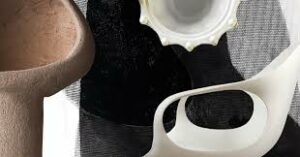
“Con Cura” is a project that has a particularly deep meaning for me. Presented at Galleria Substratum in Rome, the installation transforms the exhibition space into a dining room, evoking a domestic and intimate environment. This familiar setting was intentionally chosen to explore the themes of rituality, participation, finding and re-finding oneself. The dining room is a symbolic place, a pulsating heart of family life where everyday moments, conversations and memories are shared. Transforming the exhibition space into a domestic interior has allowed the creation of a welcoming and familiar atmosphere, in which visitors can feel enveloped and involved. The bare clay nests are positioned on the table as if they were also a joint nucleus and represent the bare essentiality and intrinsic beauty of simple life. Their arrangement is not random. Each nest is placed in such a way as to evoke a sense of protection and warmth, similar to that found in a family gathered around the table. The nests are symbols of refuge, welcome and care, elements which become central in the context of this project. The work therefore aims to encourage visitors to leave the sphere of the self to relocate themselves in a collective space, uniting their individuality with that of the others present. The ritual of meeting and re-meeting around a table takes on a new meaning in this artistic context, becoming an act of participation and sharing. The project aims to make us reflect on the value of human relationships and the need for mutual care, elements that are often overlooked in the frenzy of everyday life. “Con Cura” is therefore an invitation to rediscover the warmth of human connections, the beauty of daily rituals and the importance of feeling part of a community. Through the simplicity and essentiality of the clay nests, the project aspires to create an emotional and engaging experience, which warms the soul and invites a deep reflection on the value of taking care, of finding oneself and of re-finding oneself.
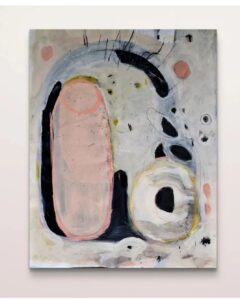
In the previous project, as in others, a unique relationship with objects and living space emerges implicitly, which is taken care of in the smallest details and conceived with the aim of improving the quality of life. What is your relationship with design?
My relationship with design is quite different from the traditional one. I do not focus on functionality or the optimization of spaces to directly improve the quality of life in a practical sense. Rather, my work seeks to raise questions and stimulate reflections through the interaction with objects and spaces. Each work is conceived to provoke an emotional or intellectual response, inviting the viewer to question their own experience and perception of the world. So, while my approach may seem distant from conventional design, it is based on the belief that art, even in its seemingly “useless” complexity, can enrich life through reflection and awareness.
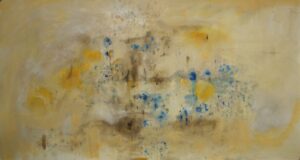
Let’s talk about the LIMINALE exhibition, hosted in 2023 at the Mondoromulo arte contemporanea gallery. Here the canvases mounted live and the sculptures create a long work of introspection, revealing an exhibition path that shows a very strong connection with the dimension of childhood. In fact, the place is where memories are awakened, the suggestions of a liminal dimension precisely, suspended between past and present, where the child has now become an adult, but still feels the struggle between perception and consciousness. Can you tell us about this project?
Absolutely. The exhibition LIMINALE is the culmination of a personal and emotional journey, a visual and tactile exploration of how childhood past can continue to influence and shape our adult identity. I have chosen to use live-mounted canvases and sculptures to create an exhibition space that acts as a bridge between the world of memories and our present experience. The works reflect the fragility and power of those formative moments that, while seemingly distant in time, continue to exert a subtle but persistent influence. The liminal dimension of the exhibition is evident in the way I have tried to capture and represent that emotional ambiguity, that undefined boundary between what we were and what we have become. The materials and forms I have chosen are designed to evoke a feeling of nostalgia and introspection, inviting the viewer to reflect on their own personal history and the continuous transformation of their own perception of themselves. In essence, LIMINALE is an ongoing dialogue between the past and the present, an invitation to explore how childhood experiences continue to live within us and influence the way we see the world.
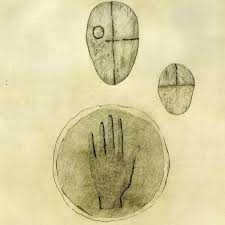
Are there any artists who inspire you?
My works are actually inspired by architectural influences that recall the work of Le Corbusier, Alvar Aalto and Tadao Ando, but also the artistic approach of Jean Arp. Le Corbusier, one of the fathers of modernism, has always attracted my attention for his organic and fluid forms, which challenge traditional geometries. I find that his rounded volumes and soft lines have a lot in common with the way I try to give life to my sculptures. At the same time, I feel very close to the work of Alvar Aalto, who used soft and organic forms in his architecture and designs, combining sensitivity towards nature and respect for materials. I cannot fail to mention Tadao Ando, whose minimalist architecture and his conception of space have deeply influenced me. My sculptures, with their irregular openings and simple surfaces, try to reflect that essentiality and that interaction with light that is so characteristic of Ando’s work. Finally, I am also inspired by the artist Jean Arp, whose exploration of biomorphic and organic forms is reflected in my way of creating. His sculptures, which almost seem to emerge spontaneously from the matter, taught me to see the form as an organic process, a natural evolution of the material itself. In short, my work is a continuous dialogue between these principles and influences, exploring the relationship between space, form and materiality, always trying to find a balance between architecture, art and nature.
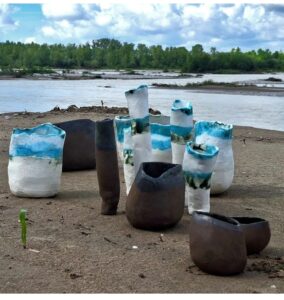
Can you tell us about your future projects?
Absolutely. Currently, I am preparing a project for an artist residency that will focus on the exploration of ceramics and its role in my artistic practice. During this residency, I will explore how ceramics can express multiple concepts through their use. Additionally, I am engaged in the programming and realization of several upcoming exhibitions that will feature both current works and new works developed during the residency. These exhibition events will provide an opportunity to explore how ceramics can visually and materially translate evocative moods and experiences. Each project represents a deep exploration of how ceramics can capture and represent the ephemeral and the imaginary, and I am excited to share these new dimensions of my work with the public.